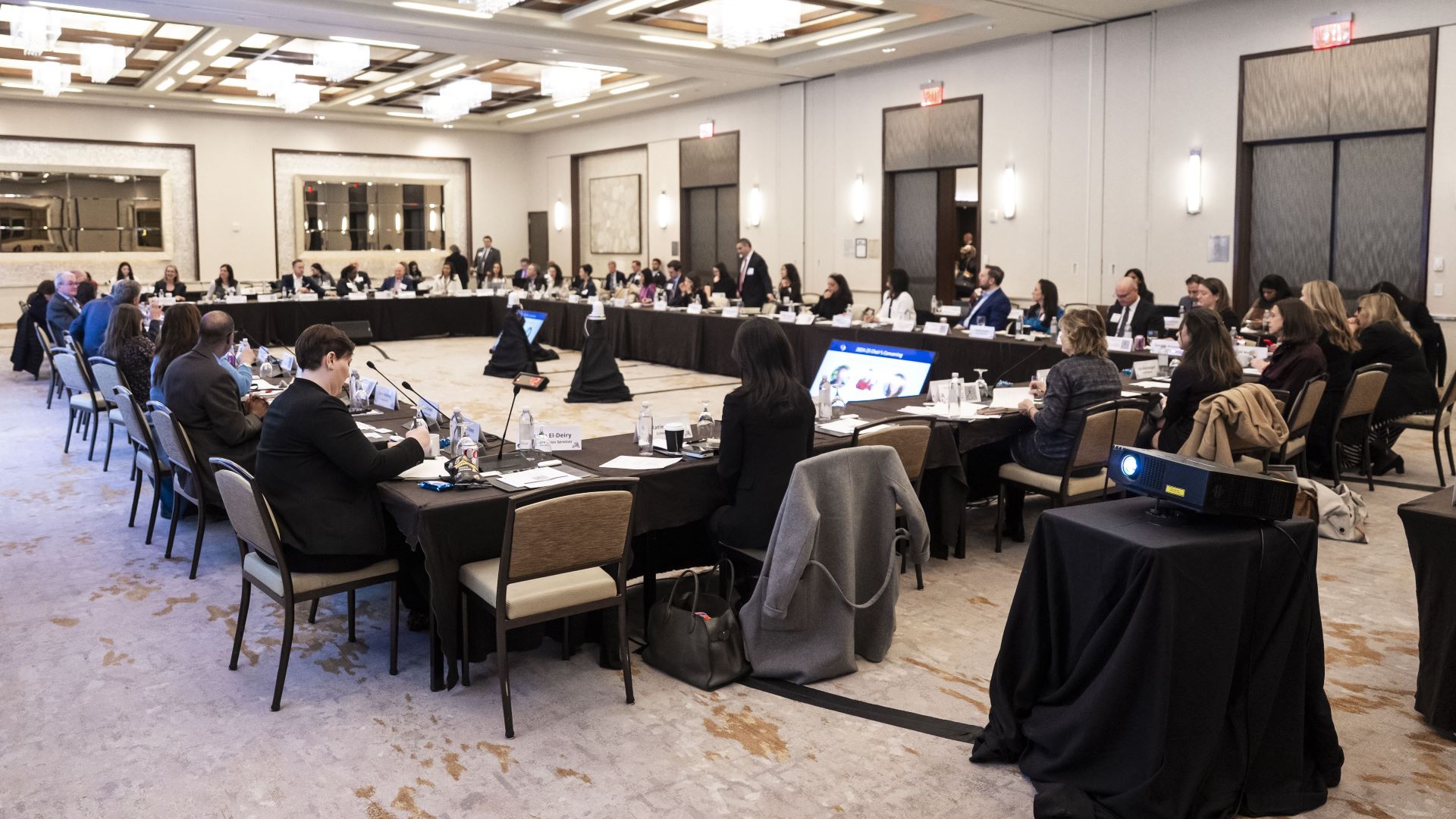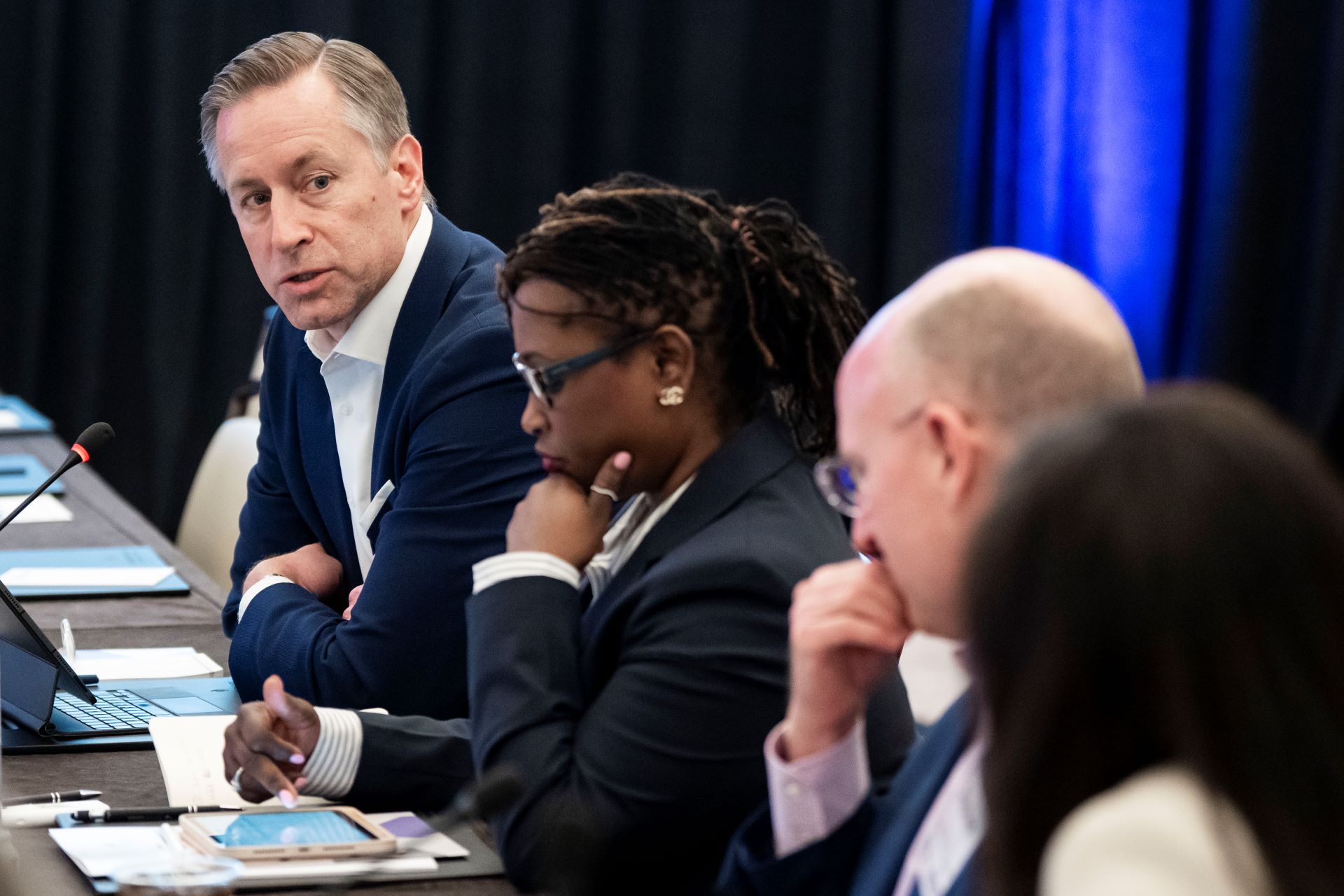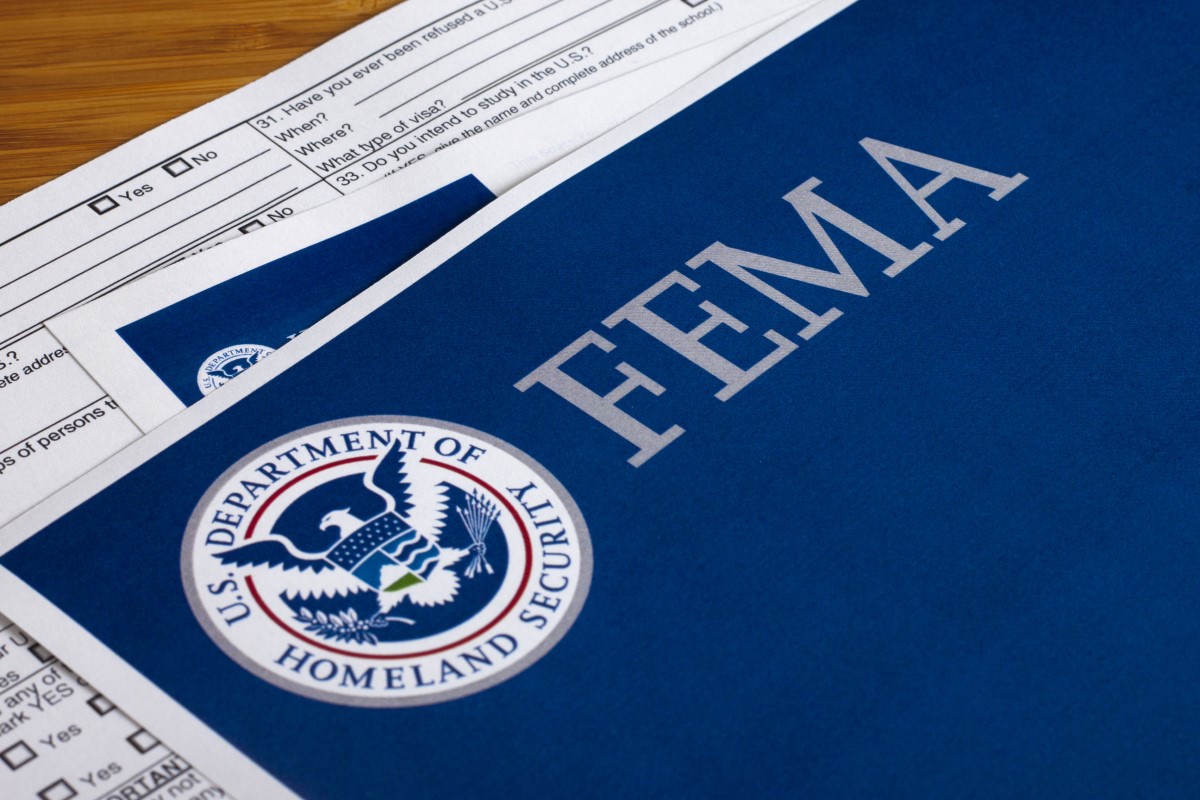As Governors across the country have taken the podium to deliver their 2025 State of the State addresses, they have used this platform to spotlight one of their largest and most consequential budget line items: education. They have celebrated key achievements in education, introduced new education initiatives, and outlined bold visions for the future of education in their states.
This is a particularly exciting year for education. NGA Chair Colorado Governor Jared Polis has launched his Let’s Get Ready!: Educating All Americans for Success Chair’s Initiative, empowering Governors to reimagine their education systems and elevate reforms that help students thrive in our rapidly evolving economy. Per Governor Polis’ own State of the State address:
“This year, I have the honor of serving as Chair of the bipartisan National Governors Association. My Chair’s Initiative, Let’s Get Ready: Educating All Americans for Success, is all about preparing students for real life and our economy for real success. We’re looking at how we can best ensure learners develop the skills and talents they need to succeed in today and tomorrow’s job market.”
Governor Jared Polis
As of mid-March, at least 49 Governors have delivered State of the State addresses. Examining these speeches offers valuable insights into the trends that are shaping education in the U.S. today. That is why for the past six years, the National Governors Association (NGA) and the Education Commission of the States (ECS) have partnered to publish a report on the education issues raised in Governors’ State of the State addresses. Across this year’s speeches, we have pinpointed seven major education policy trends that are driving Governors’ agendas: K–12 funding, workforce development and career and technical education, teacher workforce, academic achievement, school choice, early care and education, and mental and physical health. We have also identified cell phones in schools as an emerging trend.
This commentary features highlights from Governors’ State of the State and other state addresses that showcase each of these trends.
K–12 Funding
At least 32 Governors touched on funding for K–12 education in their state addresses, whether recognizing new investments or outlining updates to the state’s funding formula. This includes Governor Leon Guerrero of Guam, who dedicated $8.5 million of the territory’s latest budget to maintaining school facilities. In Maine, Governor Mills celebrated meeting the state’s obligation to pay 55 percent of local education costs in 2021 and budgeting an additional $156 million to continue this commitment. Governor Kehoe of Missouri recommended a $200 million increase to Missouri’s Foundation Formula—the state’s funding allocation model since 2005—and announced a School Funding Modernization Task Force to rewrite this formula. In Nebraska, Governor Pillen also prioritized improving the state’s school funding system, seeking to make changes to its thirty-year-old formula (TEEOSA) and announcing plans to establish a blue ribbon commission to recommend a new model. In New Hampshire, Governor Ayotte highlighted her budget’s $98.8 million dollar investment in special education—a nearly 50 percent increase from the previous biennium. Governor Kotek of Oregon elevated efforts to change how the Current Service Level funding for the State School Fund is calculated and explained that her proposed budget will help school districts with their base funding. Governor Scott of Vermont also addressed the state’s funding formula and shared details about his multi-year plan focused on a student-centered funding model, consolidation of the state’s school districts, and support for local school boards throughout the transition. Finally, though he has yet to give a State of the State address, it is worth noting that Governor Meyer of Delaware has also taken a special interest in K–12 funding, pushing for a new funding formula by the start of the 2025–26 school year.
Learn more about state education budgets and other trending topics in NGA’s State Strategies for Addressing K–12 Student Needs Webinar Series.
“As you know, we are proposing a new approach to education funding…Getting this formula right will benefit taxpayers and bring a high-quality education with more opportunities for all students from cradle to career.”
Governor Phil Scott
Workforce Development and Career and Technical Education
At least 33 Governors discussed workforce development and career and technical education as ways to prepare students for in-demand careers and bolster the economy. Governor Little of Idaho celebrated the success of the Idaho LAUNCH program, which provides grants to students who pursue workforce training programs. In Massachusetts, Governor Healey commended the thousands of learners in the state’s pathway programs and promised to continue to provide Early College and job training opportunities. In North Carolina, Governor Stein shared his goal to double the number of apprentices over the next four years, offer free community college for students who get certified in high-demand sectors, and create a Council on Workforce and Apprenticeships to better align community colleges, public schools, and local businesses. Governor Stitt of Oklahoma also stressed the need for more apprenticeships across the state, calling on businesses, schools, and universities to create 250 new opportunities before the end of the year. Governor Byran of the Virgin Islands announced that the Virgin Islands Technical College will open in September 2025. The institution will help students enter high-paying fields and address workforce shortages by giving high schoolers the opportunity to graduate with two-year college degrees and certifications. Moreover, some Governors who have yet to give a 2025 state address, including Governor Newsom of California and Governor Rhoden of South Dakota, are embracing this trend. Governor Newsom announced his Master Plan for Career Education, which outlines six strategies to strengthen career pathways and prioritize hands-on learning and real-life skills across California. Meanwhile, Governor Rhoden recently signed legislation to provide more equipment for the state’s four technical colleges.
Learn more about NGA’s Workforce Development and Economic Policy and Postsecondary Education program areas.
“Some Pennsylvanians join the workforce right out of high school. Some complete an apprenticeship. Some join the military. Some go to college. There are many paths to success, and we’ve got to respect and support all of them.”
Governor Josh Shapiro
Teacher Workforce
At least 26 Governors highlighted educator workforce needs, including teacher recruitment, retention, and compensation strategies. For example, Governor DeSantis of Florida commended the state’s record $4.6 billion budgeted to raise teacher salaries. In Hawaii, Governor Green linked the state’s teacher shortage to its lack of affordable housing, underscoring his efforts to build more residencies for educators. In Indiana, Governor Braun elevated legislation that will raise the minimum salary for public school teachers by $5,000 and require that 65% of state tuition support goes to teacher compensation. Governor Moore of Maryland lamented the state’s teacher shortage and touted his plans to launch a national campaign to recruit top educators and proposed building debt-free paths to teaching. In Pennsylvania, Governor Shapiro celebrated the creation of new student teacher stipends to help alleviate financial barriers incurred by pursuing a career as an educator Governor Abbott of Texas stated his goal to increase the average teacher’s salary to an all-time high, noting that the best teachers deserve a path to a six-figure salary. In West Virginia, Governor Morrissey emphasized the importance of paying teachers more competitively than surrounding states to attract high-quality educators.
Learn more by checking out NGA’s State Snapshots for Strengthening the Educator Workforce Webinar Series.
“As a son and a father of teachers, I’m well aware that teaching is one of the most noble professions. For too long, though, Montana teachers, especially those just beginning their careers, have not been compensated properly for their work. Over the last four years, we’ve worked together to boost starting teacher pay by establishing the TEACH Act. Building on the success of the TEACH Act, our budget invests a historic $100 million to raise teacher pay, with a focus on educators who are just starting their careers.”
Governor Greg Gianforte
Academic Achievement
At least 24 Governors addressed student achievement in their states, including efforts around literacy, numeracy, and attendance. This includes Governor Ivey of Alabama, who celebrated the state’s recent National Assessment of Educational Progress (NAEP) scores for 4th graders in reading and pointed to the Alabama Literacy Act as one of the forces behind this achievement. She also highlighted the Alabama Numeracy Act, which has helped place hundreds of math coaches in schools, and touted the impact of her Turnaround Schools initiative. Governor Dunleavy of Alaska also lauded the state’s progress in reading. Following the 2022 passage of the Alaska READS Act, the percentage of young learners in the state who met early literacy benchmarks grew from 41 percent to 57 percent—and Alaska students outpaced the national reading proficiency growth rate in kindergarten, first, and second grades. In Connecticut, Governor Lamont pointed to the Learner Engagement and Attendance Program (LEAP) as an effective strategy to combat chronic absenteeism. In New Mexico, Governor Lujan Grisham praised the state’s Structured Literacy initiative and summer literacy programs, which enrolled 10,000 students and helped spur an 11% increase in reading proficiency. Rhode Island’s Governor McKee spoke about the state’s nationally recognized Attendance Matters campaign. Governor McKee has built on this campaign to launch a $2.85 million Math Matters initiative. Governor Youngkin of Virginia emphasized the Virginia Literacy Act and ALL In Virginia—which expands access to high-dosage academic tutoring—and their positive effects on early literacy outcomes and post-pandemic learning loss. In Wyoming, Governor Gordon discussed the Reimagining and Innovating the Delivery of Education (RIDE) initiative and how it has led to improved student outcomes. Though she has yet to give a state address since her inauguration, Governor González-Colón of Puerto Rico has also shown a clear interest in academic achievement, articulating a plan to foster a stronger focus on STEM throughout the island’s schools.
Learn more about Governors’ efforts to support the academic and well-being needs of students as part NGA’s Student and School Staff Well-Being Project.
For the fundamentals, I thank the Legislature for being a partner with me in early literacy and summer learning investments. I really believe these solutions — retooling the way school districts teach our students how to read through incentivizing evidence-based practices and reducing learning disruption through reliable summer education programs — will make a difference in the future trajectory of our children and youth.
Governor Tina Kotek
School Choice

At least 21 Governors spoke about school choice and the need to provide quality educational opportunities for all students, whether by expanding the schooling options offered to families or by making sure those options are subject to thorough accountability. Governor Hobbs of Arizona called for increased accountability for the state’s Education Savings Account (ESA) program, including income caps. In Kansas, Governor Kelly stressed the importance of investing in public schools and rejecting efforts decrease their funding, including by re-routing those funds to private schools. Governor Reeves of Mississippi advocated for continuing to give parents more choices for their children’s education. In Nevada, Governor Lombardo called himself a “big believer in school choice” and celebrated the expansion of transportation options for students who choose to attend charter schools. Though Louisiana’s State of the State address is not scheduled until after the release of this commentary, Governor Landry has also voiced support for school choice. His proposed budget includes nearly $100 million for students participating in the state’s ESA program during the 2025–26 school year.
Early Care and Education

At least 24 Governors discussed the educational opportunities for young children in their states. Governor Polis of Colorado applauded the state’s jump from 27th to 7th in the nation for preschool enrollment and noted that the first class of universal preschool saved Colorado families an average of $6,100. Governor Reynolds of Iowa celebrated that more than two-thirds of the state’s 4-year-olds are enrolled in some form of preschool. She also announced an Early Childhood “Continuum of Care” grant for preschool programs and childcare providers that integrate their services. In Kentucky, Governor Beshear called for universal pre-K for all 4-year-olds, stating that 54% of children in the state are showing up for kindergarten unprepared. Governor Murphy of New Jersey recognized the state’s progress toward universal pre-K and spoke about his new proposal requiring school districts to provide full-day kindergarten in the communities that still lack it. In South Carolina, Governor McMaster proposed continued investment in the state-funded full-day 4K program, which has seen significant enrollment growth and benefits for children from low-income households. In Tennessee, Governor Lee highlighted his $11 million proposal to make childcare more accessible by partnering with the Boys and Girls Club to serve 7,500 low-income children and families across the state.
Learn more about NGA’s Children and Families program area.
Mental and Physical Health

At least 21 Governors addressed the physical, mental, and behavioral health of students. Governor Kemp of Georgia praised the funding of behavioral and mental health programs that enabled a response to the tragic shooting at Apalachee High School in 2024. In New York, Governor Hochul discussed her “Unplug and Play” initiative, which encourages young people to replace time spent on social media with healthier alternatives—like youth sports, arts programs, and community building. She also proposed providing all children with free breakfast and lunch at school and highlighted efforts to prioritize youth mental health. Governor Armstrong of North Dakota called for an expansion of the Farm-to-School program, which encourages schools to source as much food from local producers as possible. Governor DeWine of Ohio elevated the efforts of the Children’s Vision Strike Force, created to ensure that every child who needs glasses receives them, and announced the OhioSee Program to guarantee that those between kindergarten and third grade receive vision screenings. In Washington, Governor Ferguson expressed support for providing all K–12 students with free breakfast and lunch. Finally, Governor Walz of Minnesota—who has not yet given his 2025 State of the State Address—has prioritized providing free meals at school to all the state’s nearly 900,000 public school students.
Learn more about NGA’s efforts on youth mental health.
Cell Phones in Schools
Dubbed an emerging trend by NGA and ECS, at least 17 Governors talked about the harms associated with students’ use of cell phones in schools. In Arkansas, Governor Sanders touted her Bell to Bell No Cell initiative to limit cell phone distractions for students both inside and outside of the classroom. Governor Pritzker of Illinois proposed a ban on cell phone use during classroom instruction, citing the impact on learning and a rise in cyberbullying. In Michigan, Governor Whitmer expressed her support for bipartisan legislation to limit the use of phones in class, pointing to data showing that these policies lead to “more learning and less bullying.” In Montana, Governor Gianforte highlighted that his budget includes $1 million of one-time-only incentives for school districts to adopt cell phone-free policies. In his speech, Governor Cox of Utah also echoed the push to ban cell phones in schools.
As Governors continue to shape American education through policy decisions and strategic investments, their State of the State addresses offer a window into the priorities that will shape the years ahead. By tracking these trends, we get a firsthand look into how states are strengthening their education systems and better preparing students for success in an evolving world.
This article was developed by Seth Gerson and Devon Nir. Please visit NGA’s K–12 Education page for ongoing updates, webinars and resources, upcoming convenings, and technical assistance for Governors and their policy advisors.












